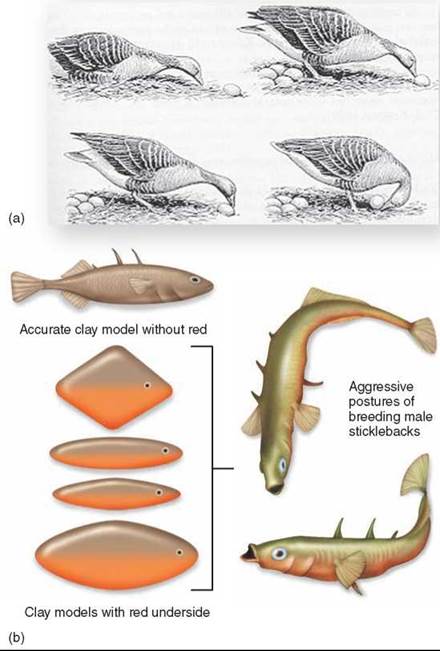THE LIVING WORLD
Unit Eight. The Living Environment
37. Behavior and the Environment
37.2. Instinctive Behavioral Patterns
Early research in the field of animal behavior focused on behavioral patterns that appeared to be instinctive (or “innate”). Because behavior in animals is often stereotyped (that is, appearing in the same way in different individuals of a species), behavioral scientists argued that the behaviors must be based on preset paths in the nervous system. In their view, these neural paths are structured from genetic blueprints and cause animals to show essentially the same behavior from the first time it is produced throughout their lives.
This study of the instinctive nature of animal behavior was typically carried out in the field rather than on laboratory animals. The study of animal behavior in natural conditions is called ethology. The three scientists most responsible for founding the field of ethology were Karl von Frisch, Konrad Lorenz, and Niko Tinbergen. These scientists were awarded the Nobel Prize in Physiology or Medicine in 1973 for their path-making contributions.
An Example of Innate Behavior
The study by Konrad Lorenz of the egg retrieval behavior of geese provides a clear example of what ethologists mean by innate behavior. The drawings in figure 37.2a illustrate how when a goose is incubating its eggs in a nest and it notices that an egg has been knocked out of the nest, it will extend its neck toward the egg, get up, and roll the egg back into the nest with a side-to-side motion of its neck while the egg is tucked beneath its bill. Even if the egg is removed during retrieval, the goose completes the behavior, as if driven by a program released by the initial sight of the egg outside the nest.
According to ethologists like Lorenz, egg retrieval behavior is triggered by a sign stimulus (also called a key stimulus), which in this case is the appearance of an egg outside the nest. The way in which nerves are connected in the goose’s brain, the innate releasing mechanism, responds to the sign stimulus by providing the neural instructions for the motor program, or fixed action pattern, which causes the goose to carry out the intricate egg retrieval behavior.
More generally, the sign stimulus is a “signal” in the environment that triggers a behavior. The innate releasing mechanism is the hard-wired element of the brain, and the fixed action pattern is the stereotyped act.
Studying fixed action patterns in birds and other animals, ethologists have discovered that in some situations, a wide variety of objects will trigger a fixed action pattern. For example, geese will attempt to roll baseballs, and even beer cans, back into their nests!
A clear example of the general nature of some sign stimuli is seen in the mating behavior of male stickleback fish studied by Niko Tinbergen. During the breeding season, males develop bright red coloration on their undersides. The males are very territorial, reacting aggressively to the approach of other males. They first perform an aggressive display (shown on the right in figure 37.2b), and if the invading male is not deterred, they attack it. However, when Niko Tinbergen observed a male stickleback in a laboratory aquarium display aggressively when a red fire- truck passed by the window, he realized that the red color was the sign stimulus. In experiments using models shown on the left in figure 37.2b, he was able to produce the aggressive display in males by challenging them with the many unfishlike models, so long as the models had a red strip.

Figure 37.2. Sign stimulus and fixed action pattern.
(a) The series of movements used by a goose to retrieve an egg is a fixed action pattern. Once it detects the sign stimulus (in this case, an egg outside the nest), the goose goes through the entire set of movements: It will extend its neck toward the egg, get up, and roll the egg back into the nest with a side-to-side motion of its neck while the egg is tucked underneath its bill. (b) In stickleback fish, a red color acts as a sign stimulus to trigger a fixed action pattern in males: aggressive threat displays or postures. When the clay models above are presented to a male stickleback, he will display less often to the first model, which looks more like a male stickleback but lacks the red belly characteristic of breeding males.
Key Learning Outcome 37.2. The ethological approach to studying animal behavior has emphasized innate, instinctive behaviors that are the result of preset pathways in the nervous system.